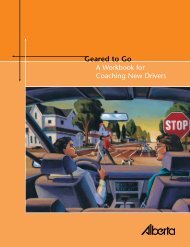Commercial driver's guide to operation, safety and licensing
Commercial driver's guide to operation, safety and licensing
Commercial driver's guide to operation, safety and licensing
You also want an ePaper? Increase the reach of your titles
YUMPU automatically turns print PDFs into web optimized ePapers that Google loves.
Resume travel<br />
• Before resuming travel, make sure<br />
there is enough room on the other side<br />
of the track for the whole unit <strong>to</strong> clear,<br />
including the vehicle’s overhang. Be<br />
aware that a train will be a metre wider<br />
than the rails on both sides.<br />
• Use a gear that will let you cross the<br />
track without shifting.<br />
• Check the crossing signals one more<br />
time before proceeding.<br />
• If the crossing lights begin <strong>to</strong> flash<br />
after starting, keep going. It is safer <strong>to</strong><br />
continue than <strong>to</strong> back up.<br />
• If there is more than one track, there may<br />
be more than one train. Do not assume<br />
the train you see is the only one.<br />
Other considerations<br />
Vehicle stalled or<br />
stuck on the tracks<br />
If your vehicle stalls or gets stuck<br />
on a crossing, get out of the vehicle<br />
immediately. If a train is coming, move<br />
away from the track <strong>to</strong>ward the oncoming<br />
train. This will reduce the chances of being<br />
struck by flying debris if the train hits the<br />
vehicle. Contact the railway company if its<br />
emergency number is posted or call 911.<br />
Viewing the tracks<br />
at a crossing<br />
Do not attempt <strong>to</strong> cross the tracks unless<br />
you can see far enough in both directions<br />
<strong>to</strong> be sure that no train is approaching.<br />
Be especially careful at crossings without<br />
gates, flashing lights or bells. Even if there<br />
are active warning signals, <strong>and</strong> they do not<br />
indicate that a train is approaching, you<br />
should still look <strong>and</strong> listen <strong>to</strong> be sure it is<br />
safe <strong>to</strong> proceed.<br />
Be cautious when approaching an<br />
uncontrolled rural railway crossing at night.<br />
A train may be crossing in front of you.<br />
The presence of a train may appear like a<br />
black, dark object against the background<br />
of a dark road.<br />
Vehicle size <strong>and</strong> clearance<br />
Know the length of your vehicle, the<br />
amount of overhang <strong>and</strong> the amount of<br />
space that is available on the other side of<br />
the railway crossing. When approaching<br />
a crossing <strong>and</strong> a STOP sign is facing you<br />
on the opposite side of the tracks, pay<br />
attention <strong>to</strong> the amount of room there is<br />
between the tracks <strong>and</strong> the sign. Be sure<br />
there is enough space <strong>to</strong> completely clear<br />
the railway tracks on the other side. If<br />
there is insufficient space <strong>and</strong> your vehicle<br />
would over hang the railway tracks you<br />
must visually <strong>and</strong> audibly ensure there is<br />
no oncoming train. Then proceed <strong>to</strong> the<br />
s<strong>to</strong>p sign <strong>and</strong> s<strong>to</strong>p. When safe, proceed,<br />
ensuring that your vehicle does not block<br />
the railway crossing for more that 20<br />
seconds<br />
Railway crossings<br />
at rural roads<br />
Pay extra attention when you cross railway<br />
tracks in rural areas because of the following:<br />
• Approach grades may be steeper.<br />
• Snow banks may be higher.<br />
• Brush <strong>and</strong> trees may be more common.<br />
• There tend <strong>to</strong> be fewer au<strong>to</strong>mated<br />
warning systems.<br />
• The grade crossing may be rough<br />
or uneven.<br />
CHAPTER TEN<br />
Responsible Driving Tips for <strong>Commercial</strong> Drivers 85




